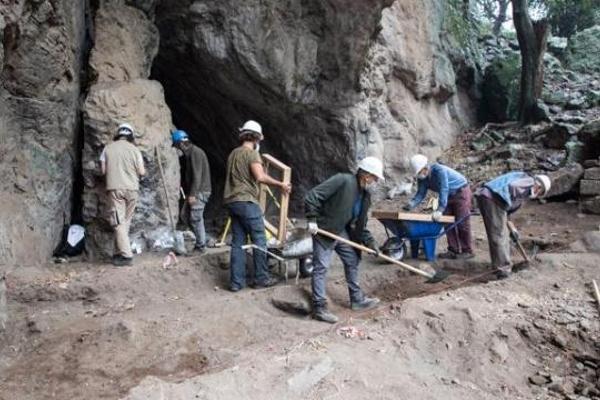Human traces dating back 14,000 years found in İzmir
İZMİR


Archaeological excavations carried out in a cave in the Dikili district of İzmir have unearthed 14,000-year-old stone tools and bones from the Late Paleolithic (Epipalaeolithic) period.
Turkish and German scientists, who carried out the works in the area, revealed that the cave was also used as a cult center dedicated to the mother goddess Kybele.
The six-week rescue excavation was carried out in a cave in Dikili under the direction of Bergama Museum during the autumn. The teams of the German Archaeological Institute and Professor Harun Taşkıran from Ankara University’s Archaeology Department took part in the excavations.
According to the information they obtained from the ancient layers, the team of Turkish and German scientists revealed that the cave was used as a cult center dedicated to Kybele from the sixth century B.C. to the Roman period.
During the surface surveys, made in parallel with the Pergamon excavations carried out by the German Archaeological Institute, layers from the Epipalaeolithic period were found in the region. Stone tools and bones were unearthed in these layers as well.
The examinations made in the laboratories using the radiocarbon dating method determined that the stone tools and bones found date back to 14,000 years.
Professor Felix Pirson, the director of the German Archaeological Institute, said that these were the first finds belonging to the Epipalaeolithic period in Western Anatolia.
Stating that Anatolia is a land that unites the east and the west throughout history, Pirson said: “The excitement created by the latest Göbeklitepe finds is one of the examples in this context. In Göbeklitepe, mankind created the first monumental architectural and plastic works in 10,000 B.C. Although the Neolithic Age, which includes Göbeklitepe in its early stages, is relatively known, we don’t have much information about the earlier Paleolithic Age. To date, several Paleolithic areas have been identified in Southern and Southeastern Anatolia, and these places are still being excavated.”
Noting that the cave was used as a short-term settlement or a seasonal campsite visited by Epipalaeolithic hunter-gatherer groups rather than a permanent settlement, Pirson said: “Tools made of flint from this period were recovered. Flint cores, technological pieces and production residues found in the archaeological fillings reveal that the flaking process was carried out in the cave. We can consider that the flint raw material was collected from the stream bed in front of the cave. But the question of where exactly people obtained the flint stone has not yet been answered.”
Pirson noted that from the sixth century B.C. to the Roman period, the cave was used as a cult center dedicated to Kybele and that the latest finds found in the cave were from the Byzantine and Ottoman periods.
The investigation of the finds, unearthed during the excavations under the direction of Pergamon Museum Director Nilgün Ustura, is being carried out within the scope of a long-term project titled the “Transformation of Pergamon Microgeography between the Hellenistic and Roman Periods,” financed by the German Research Institute (DFG).
Experts from the German Archaeological Institute and Ankara University, Manisa Celal Bayar University, Sinop University, Berlin Freie University and TÜBİTAK Marmara Research Center are participating in the rescue excavation and study of the finds.
